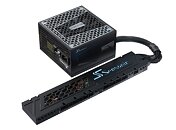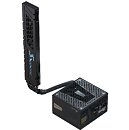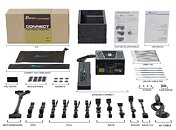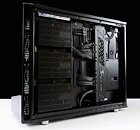Wednesday, March 4th 2020

Seasonic Rolls Out its First Connect 750W Power Supply
Way back in Computex 2019, Seasonic showed us the Connect, a concept PC power-supply that greatly de-clutters your build's power cabling spaghetti by introducing the Connect device. This is essentially a power connector spinal back-plane that runs along the height of your tower, with shorter cables emerging from it. The company announced the product's market release with a 750-Watt model, the SSR-750FA. The contraption connects to the main unit through fewer, high-gauge cables.
The business-end of the Seasonic Connect SSR-750FA is a slightly modified Prime 750 W, which is just 14 cm long, and has just the high-gauge cable emerging from it, which leads to the Connect module. Under the hood, the Prime 750 W offers single +12V rail design, 80 Plus Gold efficiency, DC to DC switching, most common electrical protection mechanisms, and a 135 mm fluid dynamic bearing fan to keep cool. Downstream connectivity of the SSR-750FA include a 24-pin ATX, two 4+4 pin EPS, four 6+2 pin PCIe power, 8-10 SATA power, and up to three 4-pin Molex. Seasonic is backing this PSU with a 10-year warranty.
The business-end of the Seasonic Connect SSR-750FA is a slightly modified Prime 750 W, which is just 14 cm long, and has just the high-gauge cable emerging from it, which leads to the Connect module. Under the hood, the Prime 750 W offers single +12V rail design, 80 Plus Gold efficiency, DC to DC switching, most common electrical protection mechanisms, and a 135 mm fluid dynamic bearing fan to keep cool. Downstream connectivity of the SSR-750FA include a 24-pin ATX, two 4+4 pin EPS, four 6+2 pin PCIe power, 8-10 SATA power, and up to three 4-pin Molex. Seasonic is backing this PSU with a 10-year warranty.





30 Comments on Seasonic Rolls Out its First Connect 750W Power Supply
Instead of making a PSU, that has terminals on the side, thus masked and not seen and more easily manageable on the case backside...
It really defeats the purpose. It needs custom cables also for this. Making the them proper length in the first place delivers the same result aesthetically. WITHOUT THE ADDED COST.
The idea is amazing btw.
Until this has been proven as reliable I'll stick with the usual.
A) Everyone's case has the necessary space behind the mobo tray (or somewhere else) to mount the strip
B) All your components are located in the bog-standard locations, whereby those REALLY short, custom made cables will be long enough to reach them (more unlikely in EATX/super/micro cases)
C) That everyone will want to swap out a standard set of standard length/sized cables, which allow for some flexibility to secure/tuck/hide them in various ways/places, for their custom cables that won't really allow for this, and won't really reduce cable clutter all that much...
D) That nobody will care that they will have ZERO options for the orientation/location of the strip, since the cable from the psu to the strip will always have to be routed according to where the psu is....
Also they don't mention the price for all of this "innovation", which will most likely be a good bit higher than a standard psu, based on the pics posted with the announcement..like the costs of the strip itself + the custom made cables....
Good luck with that :laugh:
On the other hand, I'm pretty sure not all cases even have the cable routing holes ;)
Interesting idea, but I don't think this is the correct approach. I'm much more interested in the upcoming 12V only PSUs over this.
You want quiet, Seasonic just released 3 new fanless PSUs ;)
And as a super tower user, I can tell you that the cables that come with this psu would never reach some of my components, especially my GPU & fan controller...
As for routing holes, most cases have at least 1 or 2, but that doesnt mean they are located in places that would allow these cables sufficient reach the components that they need to connect to...
Maybe this will be a turning point for PSU vendors to include 90° connectors or jumpers with new purchases too.
As it stands it's kind of limited to the cases and designs it works with.
This is one of those "There's no reason not to and why did it take this long" things.
Of course, maybe I'm biased as I went with a Fractal Define R6 on my last build.
The idea has merit; but i'd like to see some high-end cases have a "power distribution center" integrated on the back. Like; one just plugs in a full 12V PSU to the integrated center, then the center has all the ports for plugging in the necessary cables to whatever needs it; reducing some of the cable clutter and allowing use of shorter extension cables. Or failing that, a clean pass-through block, where one just plugs the PSU to the appropriate ports, and then on the motherboard side just plug in whatever extensions or custom cables is necessary to power what's on that side. Sort of like one or two of the custom Origin PCs that integrated the power distribution block in the wall separating the cable side from the motherboard side.